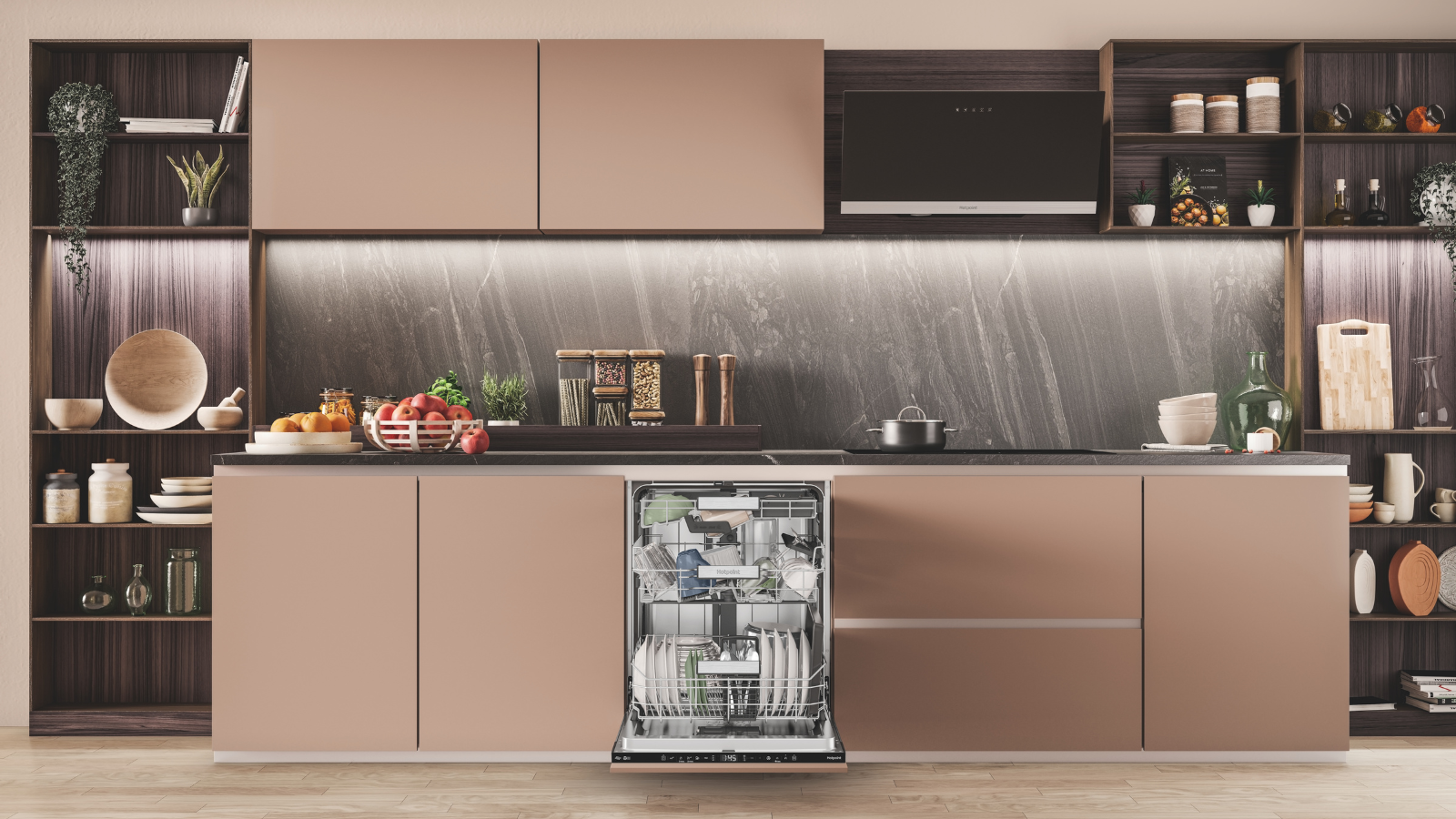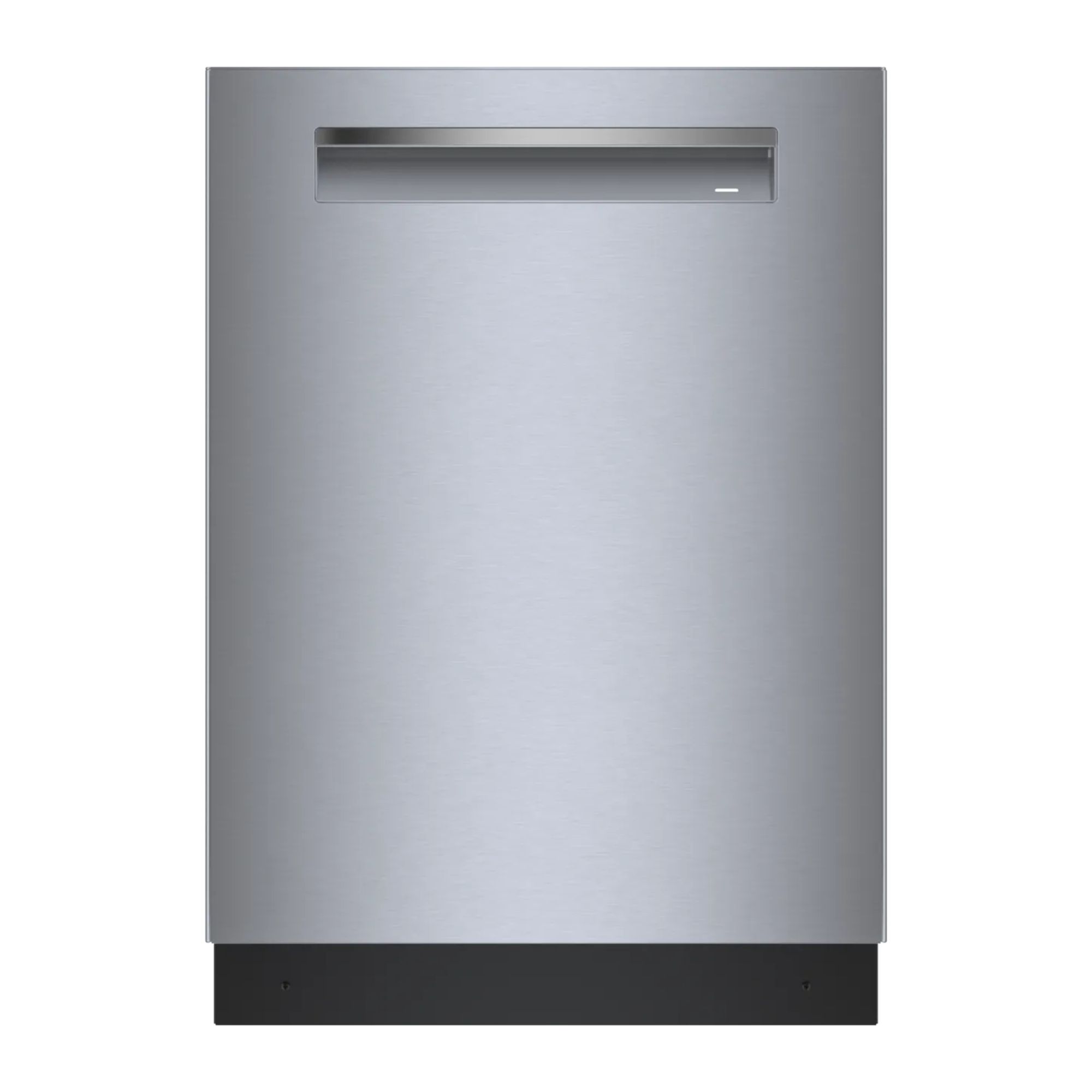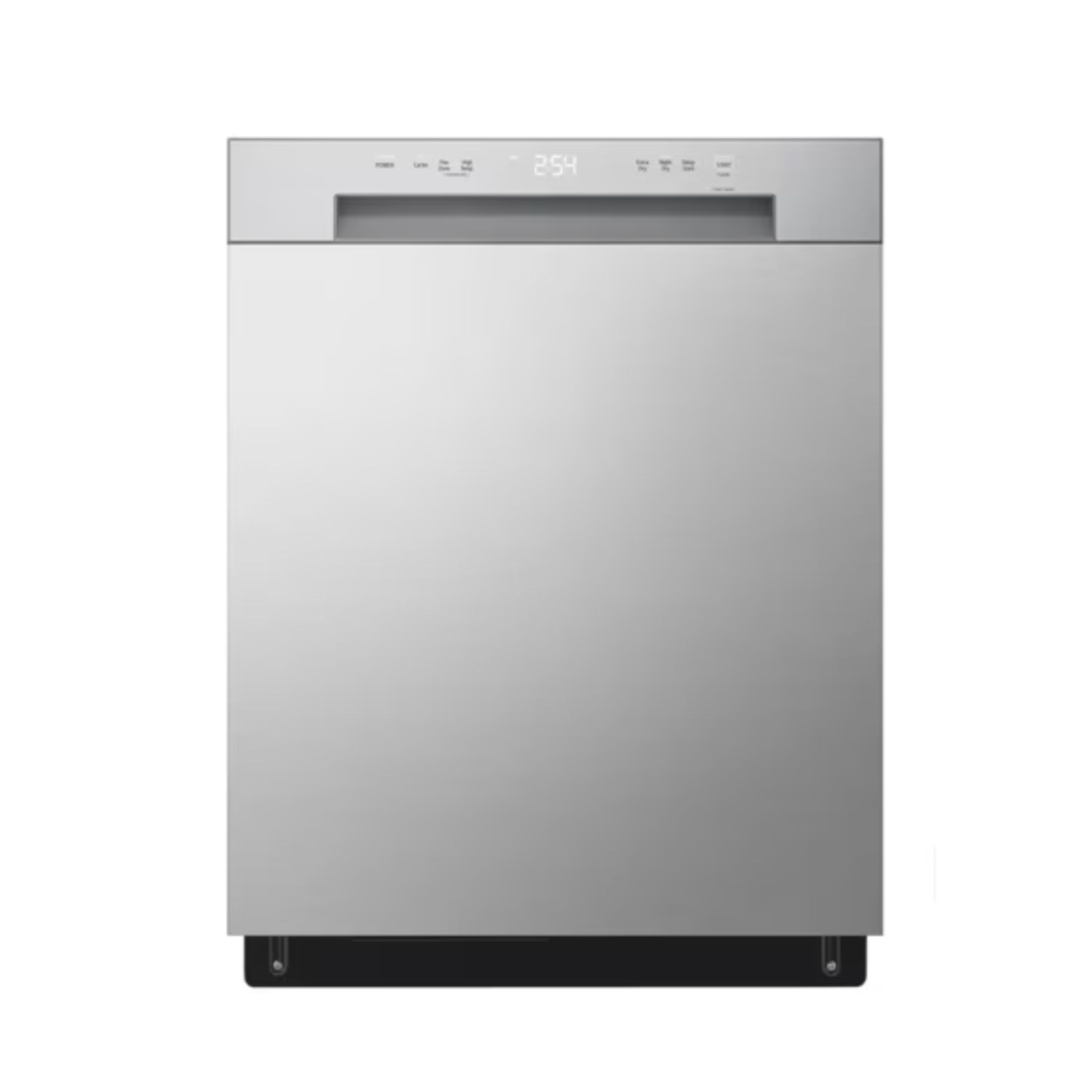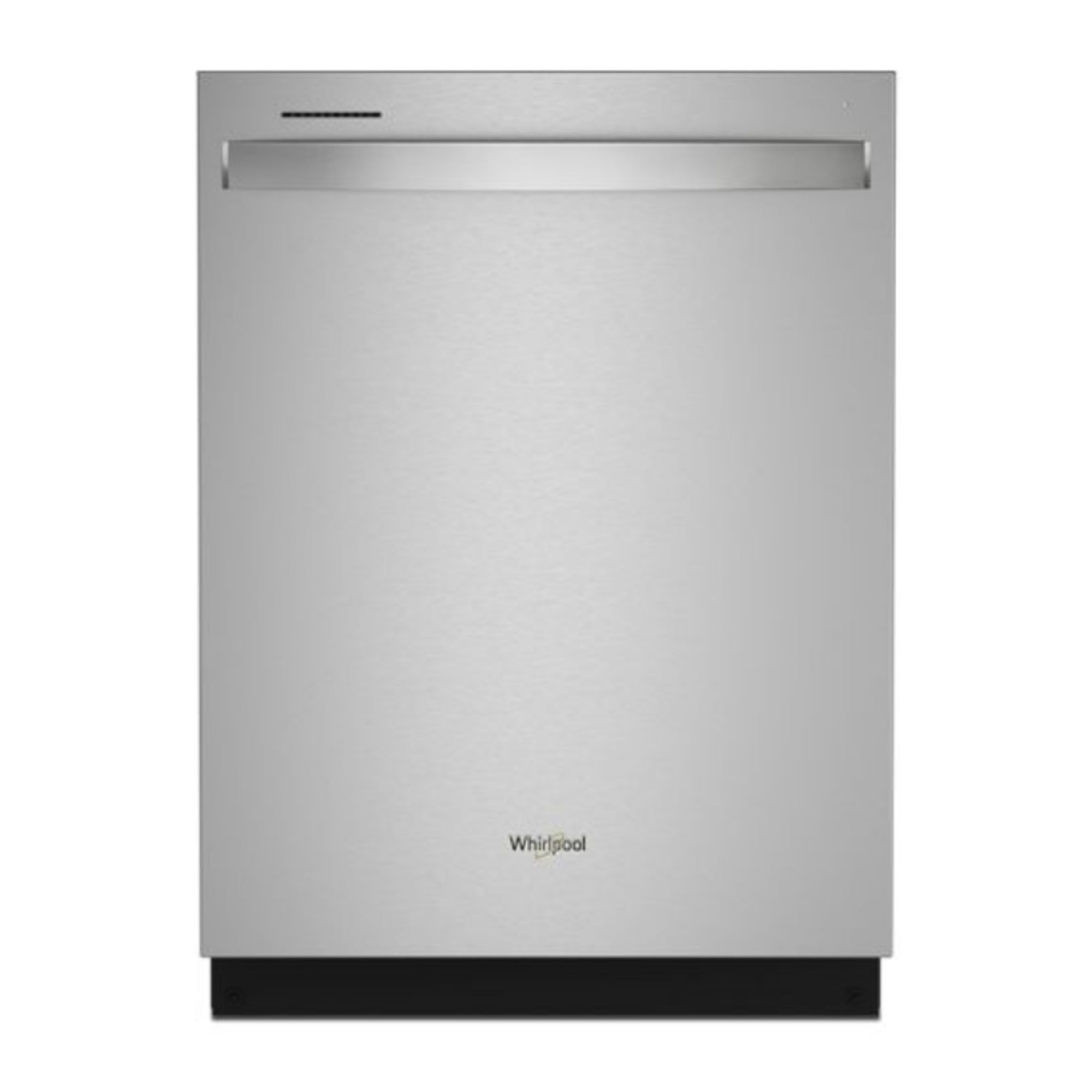Best dishwashers 2025 – everything you need to know before buying a dishwasher, plus the top three models backed by experts
I'm a professional chef, and I interviewed appliance experts, read over 1,000 customer reviews, sifted through forums and repair data, and visited five showrooms to find the best dishwasher for your kitchen

- Our expert panel
- Top 3
- Dishwasher types
- Brand comparison
- Essentials to consider
- Features to consider
- How I research
- When can you get the best deals on a dishwasher?
- Where can you buy a dishwasher?
- How can you get the most from your dishwasher?
- Should I have a cutlery basket or cutlery drawer?
- Our expert panel
- Top 3
- Dishwasher types
- Brand comparison
- Essentials to consider
- Features to consider
- How I research
- When can you get the best deals on a dishwasher?
- Where can you buy a dishwasher?
- How can you get the most from your dishwasher?
- Should I have a cutlery basket or cutlery drawer?
Having one of the best dishwashers will save your household time, conserve water and energy, and wash your cookware thoroughly for a fraction of the manual effort. But with all the different types and designs, finding the right one to suit your home's needs can seem like a mammoth task.
As a cook and keen host, I want something spacious and efficient, with plenty of adjustability for my whisks, tall blender pitchers, and best air fryer baskets. I also need a quiet dishwasher, as I have an open-plan dining space, and I'd like to run cycles at night.
But some households will prefer a compact dishwasher to preserve space, while others would benefit from smart features to take the load off a busy schedule.
Luckily, it's my job to find the best kitchen appliances on the market, so I've scrolled through over 1,000 customer and professional reviews, spoken to cleaning experts, kitchen professionals, and repair specialists. I've studied industry reports and even went undercover for this mission – visiting five major showrooms to get the scoop and see the machines in real life.
Our expert panel

Hannah Pregont is a seasoned appliance expert and creative director at AJ Madison, the number one kitchen appliance retailer in the US for over 23 years, ‘The essentials are cleaning performance, quiet operation, durability, and features that match your workflow. Choose size and racking for the way you load, not the way the brochure looks.'

Derek Bruce is the operations director at Skills Training Group and a qualified engineer, plumber, and electrician, who recommends the Bosch 800 Series, ‘42 dB is whisper-quiet, RackMatic racking is genuinely flexible, and a stainless steel interior helps both durability and drying.’

Ian Palmer-Smith is a domestic appliance service and repair expert at Domestic & General with over 35 years of professional experience, ‘You’re looking for cleaning performance across delicate glassware to heavy pans, good drying, energy-saving eco cycles, and the right size for your household.'
Farook Member is at the helm of QS Supplies, a leading supplier of appliances in the home. ‘Buying a dishwasher requires attention to some details that will ensure you have picked out the best for your needs. The most utility are those with flexible loading options and various cycle choices, and there is also the necessity of having an ENERGY STAR rating to ensure energy efficiency.'
Our top three best dishwashers

Quiet, reliable daily driver with excellent rack flexibility and intelligent cycles, recommended frequently by multiple appliance experts, including Derek Bruce, a qualified engineer, plumber, and electrician.

Recommended by appliance expert Hannah Pregont for its small footprint and great value for couples and those in small apartments, she says 'it offers strong performance without overcomplicating things.'

If you're looking for an affordable dishwasher that's still big enough for the whole house, this Whirlpool model offers solid performance without the premium price tag.
Dishwasher types

Finding the right type to fit your kitchen size and household needs is the first step to choosing the best dishwasher for you.
Built-in (typically 24-inch)
- Pros: Maximum capacity, best feature set, sleek built-in look.
- Cons: Needs proper power and water connections, installation quality affects both noise and leak risk, won’t fit smaller kitchens. Knowing where to place a dishwasher (and whether the dishwasher should sit right or left of the sink) will help with planning.
These are the default choice for best dishwashers in most homes and are installed flush with cabinets, offering space for 12–16 place settings, and usually come with the broadest set of features. For many households, this is the best balance of capacity, performance, and style.
Dishwasher noise is often the first deciding factor. 'Under 44 dBA is ideal for open layouts,' says Hannah Pregont, appliance expert and creative director at AJ Madison. A quieter dishwasher not only suits open-plan kitchens but also means you’re more likely to run all the various dishwasher cycles without disrupting conversation or TV.
Drying is another differentiator. 'Many wash cycles and sanitizing options add convenience, but drying matters day-to-day. Bosch’s advanced systems and Miele’s build quality stand out,' says Farook Member, director at QS Supplies. If you use a lot of plastics, look for zeolite-based drying or auto-open doors – these get better results than a basic heated element and help prevent dishwasher smells from lingering.
Built-ins can also include energy-saving tech like auto-wash sensors, which adjust the cycle to match how dirty your load is.
Fully-integrated (or panel-ready)
- Pros: Cleanest possible look, quiet operation, widely supported by premium brands.
- Cons: Highest price point, extra panel cost, handle compatibility, more installation considerations.
Fully integrated dishwashers hide both the controls and the front behind a furniture panel, giving you a completely seamless kitchen look. They’re especially popular in luxury renovations or design-led spaces where visual continuity is important.
'Design-focused homes often go panel-ready – Cove and Miele are favorites for integration and durability,' says Hannah. The extra weight of the door panel means build quality is crucial, so look for sturdy hinges and smooth glides so the door doesn’t sag over time.
Because the controls are hidden, it’s worth checking for a floor beam (usually a concentrated red or blue light that is projected onto the floor) or exterior light that shows when a cycle is running – otherwise, you might be opening the door mid-wash.
Compact (18-inch)
- Pros: Space-saving, uses less water when full, easier to install in small kitchens.
- Cons: Won’t fit large sheet pans or platters, frequent use can cancel out water and energy savings, noisier than some full-size models.
Ideal for apartments and small homes, these brilliant dishwashers offer the same features as full-size models but at a smaller scale – usually 8–10 place settings. Capacity is the main trade-off, so loading your dishwasher properly and knowing what should go in the top dishwasher rack are essential for good results.
'The appliance needs to be the right size for your household – overloading or running half-empty both hurt performance and efficiency,' says Ian Palmer-Smith, appliance repair expert at Domestic & General.
He warns that misusing compact dishwashers can lead to cloudy glasses in the dishwasher or lingering smells, especially if you forget to clean your dishwasher and run a monthly hot maintenance cycle.
Drawer dishwashers
- Pros: Ergonomic, allows for different cycles at the same time, efficient for smaller households.
- Cons: Less vertical space for tall items, more moving parts to maintain, higher cost per place setting than standard models.
Best for smaller, frequent loads and for reducing bending, these dishwashers open like a drawer rather than a drop-down door. Fisher & Paykel pioneered the category and still leads on fit, finish, and reliability.
'Independent wash zones are a game-changer – fragile stemware in one drawer, baked-on pans in the other,' says Farook Member. This flexibility lets you run only the space you need, cutting water and energy use. They’re also a great choice for people with limited mobility, thanks to the lighter drawer action.
Portable/countertop dishwashers
- Pros: No permanent installation, flexible placement, ideal for renters.
- Cons: Louder than built-ins, small capacity, more manual setup, takes up floor or counter space.
For renters or kitchens without a built-in space, these handy and excellent dishwashers can be surprisingly effective. Portables connect to a faucet and roll away when not in use, and countertop models are small enough to sit on your work surface (but will eat into valuable counter space).
'Avoid ultra-cheap units with plastic interiors or flimsy racks – they’re noisy and don’t last,' says Derek Bruce, operations director at Skills Training Group. He also recommends buying a good-quality faucet adapter and checking the spray arms regularly – otherwise, you might have to unclog the dishwasher to restore performance.
Comparison of the best dishwasher brands
I've put together a handy table comparing the main best dishwasher brands' prices, feature sets, and pros and cons:
Brand | Price range | Pros | Cons | Highlights |
$800-$1,500 | Exceptionally quiet, top-tier cleaning, reliable service life | Premium pricing | Up to 16 place settings, 42 dBA or quieter, CrystalDry zeolite drying, RackMatic 9-position adjustable racks, leak protection system | |
$1,400-$3,900 | Near-perfect build, excellent energy efficiency, powerful cleaning | Higher cost | AutoDos detergent dosing, QuickIntenseWash cycle in under 60 minutes, 3D MultiFlex third rack, auto-open drying, tested for 20-year lifespan | |
$500–$1,199 | Smart features, innovative QuadWash, and reliable performance | Performance varies by model | QuadWash® multi-motion wash arms, Inverter Direct Drive motor (10-year warranty), EasyRack Plus with height adjustment, 14 place settings, LoDecibel as low as 38 dBA, 1‑Hour Wash & Dry cycle, TrueSteam sanitization, ENERGY STAR rated and stainless-steel tub | |
$2,500-$3,500+ | Sleek panel-ready design, quiet, strong build | High price, limited availability | 41 dBA, three spray arms per cycle, LED interior lighting, customizable rack positions, built-in water softener, Wi-Fi control | |
$750-$1,600 | Powerful cleaning, flexible racking, positive satisfaction scores | Lower-tier models can be noisier | ProWash soil-sensing cycle, FreeFlex third rack, SatinGlide ball-bearing rails, Heat Dry option, stainless steel tub | |
$800-$1,800 | Ultra-quiet, smart features, sleek design | Mixed long-term reliability feedback | WhisperQuiet operation as low as 39 dBA, Linear Wash sliding spray arm, Zone Booster targeted cleaning, Wi-Fi SmartThings integration | |
$700-$1,400 | Great capacity and layout with targeted jets | Inconsistent drying | 39–42 dBA operation, Bottle Jets in upper rack, Microban antimicrobial surfaces, Dry Boost with fan assist, third rack storage | |
$600-$1,200 | Affordable, strong cleaning and sanitization, good value | Variable long-term reliability | Sensor cycle adjusts time/water, NSF-certified sanitize option, triple filtration system, 1-hour wash cycle, heated dry | |
$600-$900 | Excellent value, energy-efficient, quiet | Drying system less advanced | 39 dBA models available, SelfDry door opening, EverClean automatic filter cleaning, AquaIntense high-pressure zone, ENERGY STAR Most Efficient |
In simple terms, this translates to: Bosch for value and quiet volume, Miele for longevity and finish, GE Profile and KitchenAid for flexible racking, Whirlpool for budget reliability, Beko for eco features (our where to buy section below explains where these brands are available at the best prices).
‘Bosch is at the top of the list – very quiet, advanced features, and extremely reliable, but Miele’s G 7000 stands out for build quality and innovative auto-dosing,' says Farook Member. And Derek Bruce agrees, with his favorite being the Bosch 800 Series.
Punteha van Terheyden, Head of Solved, specifically picked a Bosch dishwasher for her open-plan, small home. She says, 'My previous dishwasher was so loud and disturbed us whenever it was running. My Bosch dishwasher is so quiet it's impossible to know if it's on with the beam light reflecting a red dot on the floor, and it has not become noisier over time. I've had it for three years and it continues to perform brilliantly without noise and is so reliable.'
Sources: Manufacturer websites, ENERGY STAR, Yale Appliance service data, J.D. Power dishwasher customer satisfaction studies, retailer listings, and owner feedback on retailer reviews and Q&As.
Dishwasher essentials to consider
- Size and fit: Always measure the space carefully – width, height, and depth – and don’t forget kickspace, ventilation gaps, and door swing clearance. 'Capacity is also important – the appliance needs to be the right size for you and your household, as this will impact energy efficiency,' says Ian Palmer-Smith. If you have a choice of locations, it’s most efficient to install your dishwasher near the sink for easier plumbing and loading. Knowing how to position a dishwasher in a small kitchen will help if you're limited on space.
- Installation: If you’re a confident renovator, DIY installation can be possible, but for most homes, hiring a professional is the safer choice. They’ll ensure proper water and power connections, prevent floor or cabinet damage, and may include a warranty on the work. As Derek Bruce notes, the installation quality can affect not only performance but also noise and leak risk over time. A professional can also make sure you’re avoiding common dishwasher mistakes from day one.
- Accessibility and ergonomics: For those with mobility concerns or who simply want to avoid unnecessary bending, drawer dishwashers are a great option, and even a standard 24-inch built-in can be installed slightly higher in a custom cabinet. Farook Member points out that 'flexible loading options' are essential for day-to-day comfort, especially if you’re using your dishwasher multiple times a day. Interior LED lighting – found in some premium models – is also surprisingly helpful for spotting stray utensils or debris that could block the spray arms, which is a common cause of dishwashers not cleaning properly.
Dishwasher features to consider
When choosing your dishwasher, I always recommend going through every feature. You'll thank yourself years from now when your dishwasher is perfectly suited to your kitchen and routine.
- Cleaning performance: 'Generally, you're looking for cleaning performance – does it clean delicate glassware to heavy pans with caked-on grease and grime?' says Ian Palmer-Smith. This is where you’ll notice the difference between a budget and a premium machine. Look for multiple spray arms or targeted jets (GE Profile’s Bottle Jets are a good example), soil sensors that adjust the cycle, and specialist wash zones for stubborn cookware. Stainless steel tubs tend to boost cleaning and drying results, and flexible racks help water reach every item. If your dishes are coming out dirty, you may need to check for dishwasher loading mistakes or clogged spray arms before blaming the machine.
- Auto-wash cycles: Farook Member recommends looking for 'many wash cycles and sanitizing options [that] add convenience and performance with the addition of a quick wash mode.' Auto-wash cycles go a step further, using soil sensors to detect how dirty your dishes are and adjust the time, temperature, and water use accordingly. Many dishwasher cycles already have eco settings, but auto-wash gives you a hands-off approach that works for both lightly soiled wine glasses and caked-on pans. Miele, Bosch, and GE Profile all excel in this area.
- Noise level: 'Quiet running' is one of the first things Derek Bruce points to when recommending the Bosch 800 Series. Noise is measured in decibels (dBA) – anything under 44 is considered ultra-quiet, and premium machines can go as low as 39–42. If you have an open-plan kitchen or run your dishwasher at night, aim for the lowest possible dBA. Samsung, Bosch, and Beko all offer excellent low-noise options, but be aware that older or entry-level models may be less discreet.
- Rack flexibility: A flexible interior means fewer awkward hand-washes. Derek Bruce highlights the Bosch RackMatic system as a standout, with 'three height levels and up to nine possible rack positions' to fit a range of load sizes. Adjustable racks, foldable tines, and third racks allow you to fit larger pots, odd-shaped serving dishes, or tall glassware more easily.
- Smart controls and Wi-Fi: Smart features aren’t essential, but they can be genuinely useful in busy households and can add nicely to your smart home setup. A great example is Miele AutoDos, with detergent dosing linked to a smartphone app so the machine releases the exact right amount for each cycle. Wi-Fi connectivity can also alert you to maintenance needs, track energy use, or start cycles remotely. Hannah Pregont says to look for 'features that match your household’s habits' – for some, that may mean smart control, for others, it could be as simple as a favorite quick wash program.
- Sanitization cycles: Sanitization modes use higher water temperatures to kill bacteria, which is ideal if you have young children, allergies, or a family prone to illness. NSF-certified sanitization functions are a good benchmark here, just be aware they may add to the cycle time, so you’ll want to balance hygiene needs with convenience.
- Self-clean and maintenance modes: Over time, grease, food particles, and limescale can build up inside your dishwasher, affecting performance and even shortening its lifespan. Farook Member advises avoiding 'dishwashers with plastic interiors' partly because they can be harder to keep clean and don't contribute to a non-toxic home. Self-clean cycles, like those on Beko’s EverClean filter systems, can reduce the upkeep, but you should still clean your dishwasher regularly, run a vinegar rinse, and check spray arms to keep water flowing freely.
- Eco features: If efficiency is a priority, look for the ENERGY STAR Most Efficient label. 'Make sure that it is efficient and quiet,' says Farook Member. Many eco-friendly models use less than 3 gallons of water per cycle and have low standby energy use. Features like auto-shutoff, door-open drying, and heat exchangers can reduce your running costs further.
Drying methods and any drying technology included in the best dishwashers can make or break your post-cycle experience.
'Is it good at drying items without leaving pesky watermarks?' Ian Palmer-Smith advises asking when choosing a dishwasher. The drying methods are:
- Heat element drying: Warms the tub so water evaporates. It’s fast but uses more energy.
- Auto-open drying: The door opens slightly at the end of the cycle to let steam escape naturally – a big plus for reducing cloudy glasses.
- Zeolite-based drying: Found in high-end Bosch and Thermador dishwashers, this uses minerals to absorb moisture and release heat, so plastics dry thoroughly without extra energy.
How I researched the best dishwashers
As a chef, I know firsthand that a reliable dishwasher is the backbone of an efficient kitchen. When you’re cooking multiple meals a day, the last thing you want is to waste time re-washing dishes or dealing with a machine that's gone wrong.
I’ve spent my life using some of the best dishwashers, including top-of-the-line models in professional kitchens, and some truly awful ones in rented flats, which left gunk on my plates and forced me to clean the dishwasher filter every morning before I could even make a coffee. That experience has made me obsessed with finding a dishwasher that does its job properly.
To research this guide, I went undercover on Wigmore Street in London – the famous kitchen district – visiting five separate showrooms: Siemens, Fisher & Paykel, Miele, Smeg, and Gaggenau. I spoke to industry experts at each location, asking them about design, energy use, durability, and features that genuinely matter in daily use. I wasn't able to use the dishwashers themselves, but I opened up and explored the models, so I could see how standards differ between brands and price points.
To assess longevity and reliability, I consulted four industry experts who know exactly which brands are worth it and which are notorious for multiple repairs. I also relied on repair statistics from Yale Appliances, customer satisfaction surveys at J.D. Power, and consulted Energy Star and QuietMark to identify models that meet their high standards.
I was able to get some hands-on testing with Bosch, Fisher & Paykel, and Miele appliances, but I didn't just rely on my thoughts. I analyzed customer reviews from AO.com, Best Buy, Lowe’s, and Home Depot for all the recommendations in this guide.
I didn’t just look at average ratings – I went deeper, reading the top three and bottom three reviews to understand common bugbears and praise. It was important to me to read reviews thoroughly, as often, low-scoring reviews reveal frustrations with delivery or installation by the individual retailers, rather than the machine itself.
I’ve only included the very best dishwashers and buying considerations in this guide. For more about how we test, visit our dedicated page.
FAQs
When can you get the best deals on a dishwasher?
Holiday weekends (Presidents’ Day, Memorial Day) and late-autumn sale events (Black Friday, Prime Day) bring steep discounts. Changeovers from previous stock often means quiet savings on outgoing models.
If you’re budgeting, factor in running costs and learn exactly how much it costs to run a dishwasher.
Where can you buy a dishwasher?
Bosch, KitchenAid, GE Profile, Whirlpool, Samsung, Beko and LG sell dishwashers directly, or are widely available at major US retailers and kitchen specialists.
Best Buy, Lowe’s, Home Depot and Sears are the best retailers to shop for a new dishwasher, and are more likely to run promotions than the manufacturers themselves.
Miele, Cove, Fisher & Paykel are best sourced via appliance showrooms who can support with installation.
How can you get the most from your dishwasher?
Regular care and cleaning your dishwasher keeps it cleaning at its best and extends its lifespan. Think of it as a low-effort routine that prevents bigger problems later on.
- Monthly: Clean the dishwasher filters to remove trapped food, and wipe the door gaskets to stop mold or mildew from forming. You can even clean your dishwasher with vinegar and run a hot maintenance cycle. This helps remove grease, mineral deposits, and lingering smells before they become stubborn.
- Quarterly: Check the spray-arm holes for clogs, inspect racks and runners for wear, and fix any wobble early – this dishwasher maintenance trick can save you from costly repairs.
- Every load: Avoid overcrowding so water can circulate freely, scrape away heavy soils before loading, and use a rinse aid to prevent streaks. To get rid of dishwasher smells, keep moisture from getting trapped by leaving the door ajar after a cycle and regularly
Should I have a cutlery basket or cutlery drawer?
A cutlery basket usually sits on the lower rack, and you can take it in and out with ease to load or empty. A cutlery drawer is a pull-out feature at the top of the dishwasher. This frees up space in your lower rack, is easily accessible if you have trouble bending, but it might impact the height of the glasses, cups, and other items you can fit in your upper rack.
For more appliance expertise, browse through our tried-and-tested guides for the best vacuum cleaners and the best non-toxic air fryers.
Having one of the best dishwashers will save your household time, conserve water and energy, and wash your cookware thoroughly for a fraction of the manual effort. But with all the different types and designs, finding the right one to suit your home's needs can seem like a mammoth task.
As a cook and keen host, I want something spacious and efficient, with plenty of adjustability for my whisks, tall blender pitchers, and best air fryer baskets. I also need a quiet dishwasher, as I have an open-plan dining space, and I'd like to run cycles at night.
But some households will prefer a compact dishwasher to preserve space, while others would benefit from smart features to take the load off a busy schedule.
Luckily, it's my job to find the best kitchen appliances on the market, so I've scrolled through over 1,000 customer and professional reviews, spoken to cleaning experts, kitchen professionals, and repair specialists. I've studied industry reports and even went undercover for this mission – visiting five major showrooms to get the scoop and see the machines in real life.
Our expert panel

Hannah Pregont is a seasoned appliance expert and creative director at AJ Madison, the number one kitchen appliance retailer in the US for over 23 years, ‘The essentials are cleaning performance, quiet operation, durability, and features that match your workflow. Choose size and racking for the way you load, not the way the brochure looks.'

Derek Bruce is the operations director at Skills Training Group and a qualified engineer, plumber, and electrician, who recommends the Bosch 800 Series, ‘42 dB is whisper-quiet, RackMatic racking is genuinely flexible, and a stainless steel interior helps both durability and drying.’

Ian Palmer-Smith is a domestic appliance service and repair expert at Domestic & General with over 35 years of professional experience, ‘You’re looking for cleaning performance across delicate glassware to heavy pans, good drying, energy-saving eco cycles, and the right size for your household.'
Farook Member is at the helm of QS Supplies, a leading supplier of appliances in the home. ‘Buying a dishwasher requires attention to some details that will ensure you have picked out the best for your needs. The most utility are those with flexible loading options and various cycle choices, and there is also the necessity of having an ENERGY STAR rating to ensure energy efficiency.'
Our top three best dishwashers

Quiet, reliable daily driver with excellent rack flexibility and intelligent cycles, recommended frequently by multiple appliance experts, including Derek Bruce, a qualified engineer, plumber, and electrician.

Recommended by appliance expert Hannah Pregont for its small footprint and great value for couples and those in small apartments, she says 'it offers strong performance without overcomplicating things.'

If you're looking for an affordable dishwasher that's still big enough for the whole house, this Whirlpool model offers solid performance without the premium price tag.
Dishwasher types

Finding the right type to fit your kitchen size and household needs is the first step to choosing the best dishwasher for you.
Built-in (typically 24-inch)
- Pros: Maximum capacity, best feature set, sleek built-in look.
- Cons: Needs proper power and water connections, installation quality affects both noise and leak risk, won’t fit smaller kitchens. Knowing where to place a dishwasher (and whether the dishwasher should sit right or left of the sink) will help with planning.
These are the default choice for best dishwashers in most homes and are installed flush with cabinets, offering space for 12–16 place settings, and usually come with the broadest set of features. For many households, this is the best balance of capacity, performance, and style.
Dishwasher noise is often the first deciding factor. 'Under 44 dBA is ideal for open layouts,' says Hannah Pregont, appliance expert and creative director at AJ Madison. A quieter dishwasher not only suits open-plan kitchens but also means you’re more likely to run all the various dishwasher cycles without disrupting conversation or TV.
Drying is another differentiator. 'Many wash cycles and sanitizing options add convenience, but drying matters day-to-day. Bosch’s advanced systems and Miele’s build quality stand out,' says Farook Member, director at QS Supplies. If you use a lot of plastics, look for zeolite-based drying or auto-open doors – these get better results than a basic heated element and help prevent dishwasher smells from lingering.
Built-ins can also include energy-saving tech like auto-wash sensors, which adjust the cycle to match how dirty your load is.
Fully-integrated (or panel-ready)
- Pros: Cleanest possible look, quiet operation, widely supported by premium brands.
- Cons: Highest price point, extra panel cost, handle compatibility, more installation considerations.
Fully integrated dishwashers hide both the controls and the front behind a furniture panel, giving you a completely seamless kitchen look. They’re especially popular in luxury renovations or design-led spaces where visual continuity is important.
'Design-focused homes often go panel-ready – Cove and Miele are favorites for integration and durability,' says Hannah. The extra weight of the door panel means build quality is crucial, so look for sturdy hinges and smooth glides so the door doesn’t sag over time.
Because the controls are hidden, it’s worth checking for a floor beam (usually a concentrated red or blue light that is projected onto the floor) or exterior light that shows when a cycle is running – otherwise, you might be opening the door mid-wash.
Compact (18-inch)
- Pros: Space-saving, uses less water when full, easier to install in small kitchens.
- Cons: Won’t fit large sheet pans or platters, frequent use can cancel out water and energy savings, noisier than some full-size models.
Ideal for apartments and small homes, these brilliant dishwashers offer the same features as full-size models but at a smaller scale – usually 8–10 place settings. Capacity is the main trade-off, so loading your dishwasher properly and knowing what should go in the top dishwasher rack are essential for good results.
'The appliance needs to be the right size for your household – overloading or running half-empty both hurt performance and efficiency,' says Ian Palmer-Smith, appliance repair expert at Domestic & General.
He warns that misusing compact dishwashers can lead to cloudy glasses in the dishwasher or lingering smells, especially if you forget to clean your dishwasher and run a monthly hot maintenance cycle.
Drawer dishwashers
- Pros: Ergonomic, allows for different cycles at the same time, efficient for smaller households.
- Cons: Less vertical space for tall items, more moving parts to maintain, higher cost per place setting than standard models.
Best for smaller, frequent loads and for reducing bending, these dishwashers open like a drawer rather than a drop-down door. Fisher & Paykel pioneered the category and still leads on fit, finish, and reliability.
'Independent wash zones are a game-changer – fragile stemware in one drawer, baked-on pans in the other,' says Farook Member. This flexibility lets you run only the space you need, cutting water and energy use. They’re also a great choice for people with limited mobility, thanks to the lighter drawer action.
Portable/countertop dishwashers
- Pros: No permanent installation, flexible placement, ideal for renters.
- Cons: Louder than built-ins, small capacity, more manual setup, takes up floor or counter space.
For renters or kitchens without a built-in space, these handy and excellent dishwashers can be surprisingly effective. Portables connect to a faucet and roll away when not in use, and countertop models are small enough to sit on your work surface (but will eat into valuable counter space).
'Avoid ultra-cheap units with plastic interiors or flimsy racks – they’re noisy and don’t last,' says Derek Bruce, operations director at Skills Training Group. He also recommends buying a good-quality faucet adapter and checking the spray arms regularly – otherwise, you might have to unclog the dishwasher to restore performance.
Comparison of the best dishwasher brands
I've put together a handy table comparing the main best dishwasher brands' prices, feature sets, and pros and cons:
Brand | Price range | Pros | Cons | Highlights |
$800-$1,500 | Exceptionally quiet, top-tier cleaning, reliable service life | Premium pricing | Up to 16 place settings, 42 dBA or quieter, CrystalDry zeolite drying, RackMatic 9-position adjustable racks, leak protection system | |
$1,400-$3,900 | Near-perfect build, excellent energy efficiency, powerful cleaning | Higher cost | AutoDos detergent dosing, QuickIntenseWash cycle in under 60 minutes, 3D MultiFlex third rack, auto-open drying, tested for 20-year lifespan | |
$500–$1,199 | Smart features, innovative QuadWash, and reliable performance | Performance varies by model | QuadWash® multi-motion wash arms, Inverter Direct Drive motor (10-year warranty), EasyRack Plus with height adjustment, 14 place settings, LoDecibel as low as 38 dBA, 1‑Hour Wash & Dry cycle, TrueSteam sanitization, ENERGY STAR rated and stainless-steel tub | |
$2,500-$3,500+ | Sleek panel-ready design, quiet, strong build | High price, limited availability | 41 dBA, three spray arms per cycle, LED interior lighting, customizable rack positions, built-in water softener, Wi-Fi control | |
$750-$1,600 | Powerful cleaning, flexible racking, positive satisfaction scores | Lower-tier models can be noisier | ProWash soil-sensing cycle, FreeFlex third rack, SatinGlide ball-bearing rails, Heat Dry option, stainless steel tub | |
$800-$1,800 | Ultra-quiet, smart features, sleek design | Mixed long-term reliability feedback | WhisperQuiet operation as low as 39 dBA, Linear Wash sliding spray arm, Zone Booster targeted cleaning, Wi-Fi SmartThings integration | |
$700-$1,400 | Great capacity and layout with targeted jets | Inconsistent drying | 39–42 dBA operation, Bottle Jets in upper rack, Microban antimicrobial surfaces, Dry Boost with fan assist, third rack storage | |
$600-$1,200 | Affordable, strong cleaning and sanitization, good value | Variable long-term reliability | Sensor cycle adjusts time/water, NSF-certified sanitize option, triple filtration system, 1-hour wash cycle, heated dry | |
$600-$900 | Excellent value, energy-efficient, quiet | Drying system less advanced | 39 dBA models available, SelfDry door opening, EverClean automatic filter cleaning, AquaIntense high-pressure zone, ENERGY STAR Most Efficient |
In simple terms, this translates to: Bosch for value and quiet volume, Miele for longevity and finish, GE Profile and KitchenAid for flexible racking, Whirlpool for budget reliability, Beko for eco features (our where to buy section below explains where these brands are available at the best prices).
‘Bosch is at the top of the list – very quiet, advanced features, and extremely reliable, but Miele’s G 7000 stands out for build quality and innovative auto-dosing,' says Farook Member. And Derek Bruce agrees, with his favorite being the Bosch 800 Series.
Punteha van Terheyden, Head of Solved, specifically picked a Bosch dishwasher for her open-plan, small home. She says, 'My previous dishwasher was so loud and disturbed us whenever it was running. My Bosch dishwasher is so quiet it's impossible to know if it's on with the beam light reflecting a red dot on the floor, and it has not become noisier over time. I've had it for three years and it continues to perform brilliantly without noise and is so reliable.'
Sources: Manufacturer websites, ENERGY STAR, Yale Appliance service data, J.D. Power dishwasher customer satisfaction studies, retailer listings, and owner feedback on retailer reviews and Q&As.
Dishwasher essentials to consider
- Size and fit: Always measure the space carefully – width, height, and depth – and don’t forget kickspace, ventilation gaps, and door swing clearance. 'Capacity is also important – the appliance needs to be the right size for you and your household, as this will impact energy efficiency,' says Ian Palmer-Smith. If you have a choice of locations, it’s most efficient to install your dishwasher near the sink for easier plumbing and loading. Knowing how to position a dishwasher in a small kitchen will help if you're limited on space.
- Installation: If you’re a confident renovator, DIY installation can be possible, but for most homes, hiring a professional is the safer choice. They’ll ensure proper water and power connections, prevent floor or cabinet damage, and may include a warranty on the work. As Derek Bruce notes, the installation quality can affect not only performance but also noise and leak risk over time. A professional can also make sure you’re avoiding common dishwasher mistakes from day one.
- Accessibility and ergonomics: For those with mobility concerns or who simply want to avoid unnecessary bending, drawer dishwashers are a great option, and even a standard 24-inch built-in can be installed slightly higher in a custom cabinet. Farook Member points out that 'flexible loading options' are essential for day-to-day comfort, especially if you’re using your dishwasher multiple times a day. Interior LED lighting – found in some premium models – is also surprisingly helpful for spotting stray utensils or debris that could block the spray arms, which is a common cause of dishwashers not cleaning properly.
Dishwasher features to consider
When choosing your dishwasher, I always recommend going through every feature. You'll thank yourself years from now when your dishwasher is perfectly suited to your kitchen and routine.
- Cleaning performance: 'Generally, you're looking for cleaning performance – does it clean delicate glassware to heavy pans with caked-on grease and grime?' says Ian Palmer-Smith. This is where you’ll notice the difference between a budget and a premium machine. Look for multiple spray arms or targeted jets (GE Profile’s Bottle Jets are a good example), soil sensors that adjust the cycle, and specialist wash zones for stubborn cookware. Stainless steel tubs tend to boost cleaning and drying results, and flexible racks help water reach every item. If your dishes are coming out dirty, you may need to check for dishwasher loading mistakes or clogged spray arms before blaming the machine.
- Auto-wash cycles: Farook Member recommends looking for 'many wash cycles and sanitizing options [that] add convenience and performance with the addition of a quick wash mode.' Auto-wash cycles go a step further, using soil sensors to detect how dirty your dishes are and adjust the time, temperature, and water use accordingly. Many dishwasher cycles already have eco settings, but auto-wash gives you a hands-off approach that works for both lightly soiled wine glasses and caked-on pans. Miele, Bosch, and GE Profile all excel in this area.
- Noise level: 'Quiet running' is one of the first things Derek Bruce points to when recommending the Bosch 800 Series. Noise is measured in decibels (dBA) – anything under 44 is considered ultra-quiet, and premium machines can go as low as 39–42. If you have an open-plan kitchen or run your dishwasher at night, aim for the lowest possible dBA. Samsung, Bosch, and Beko all offer excellent low-noise options, but be aware that older or entry-level models may be less discreet.
- Rack flexibility: A flexible interior means fewer awkward hand-washes. Derek Bruce highlights the Bosch RackMatic system as a standout, with 'three height levels and up to nine possible rack positions' to fit a range of load sizes. Adjustable racks, foldable tines, and third racks allow you to fit larger pots, odd-shaped serving dishes, or tall glassware more easily.
- Smart controls and Wi-Fi: Smart features aren’t essential, but they can be genuinely useful in busy households and can add nicely to your smart home setup. A great example is Miele AutoDos, with detergent dosing linked to a smartphone app so the machine releases the exact right amount for each cycle. Wi-Fi connectivity can also alert you to maintenance needs, track energy use, or start cycles remotely. Hannah Pregont says to look for 'features that match your household’s habits' – for some, that may mean smart control, for others, it could be as simple as a favorite quick wash program.
- Sanitization cycles: Sanitization modes use higher water temperatures to kill bacteria, which is ideal if you have young children, allergies, or a family prone to illness. NSF-certified sanitization functions are a good benchmark here, just be aware they may add to the cycle time, so you’ll want to balance hygiene needs with convenience.
- Self-clean and maintenance modes: Over time, grease, food particles, and limescale can build up inside your dishwasher, affecting performance and even shortening its lifespan. Farook Member advises avoiding 'dishwashers with plastic interiors' partly because they can be harder to keep clean and don't contribute to a non-toxic home. Self-clean cycles, like those on Beko’s EverClean filter systems, can reduce the upkeep, but you should still clean your dishwasher regularly, run a vinegar rinse, and check spray arms to keep water flowing freely.
- Eco features: If efficiency is a priority, look for the ENERGY STAR Most Efficient label. 'Make sure that it is efficient and quiet,' says Farook Member. Many eco-friendly models use less than 3 gallons of water per cycle and have low standby energy use. Features like auto-shutoff, door-open drying, and heat exchangers can reduce your running costs further.
Drying methods and any drying technology included in the best dishwashers can make or break your post-cycle experience.
'Is it good at drying items without leaving pesky watermarks?' Ian Palmer-Smith advises asking when choosing a dishwasher. The drying methods are:
- Heat element drying: Warms the tub so water evaporates. It’s fast but uses more energy.
- Auto-open drying: The door opens slightly at the end of the cycle to let steam escape naturally – a big plus for reducing cloudy glasses.
- Zeolite-based drying: Found in high-end Bosch and Thermador dishwashers, this uses minerals to absorb moisture and release heat, so plastics dry thoroughly without extra energy.
How I researched the best dishwashers
As a chef, I know firsthand that a reliable dishwasher is the backbone of an efficient kitchen. When you’re cooking multiple meals a day, the last thing you want is to waste time re-washing dishes or dealing with a machine that's gone wrong.
I’ve spent my life using some of the best dishwashers, including top-of-the-line models in professional kitchens, and some truly awful ones in rented flats, which left gunk on my plates and forced me to clean the dishwasher filter every morning before I could even make a coffee. That experience has made me obsessed with finding a dishwasher that does its job properly.
To research this guide, I went undercover on Wigmore Street in London – the famous kitchen district – visiting five separate showrooms: Siemens, Fisher & Paykel, Miele, Smeg, and Gaggenau. I spoke to industry experts at each location, asking them about design, energy use, durability, and features that genuinely matter in daily use. I wasn't able to use the dishwashers themselves, but I opened up and explored the models, so I could see how standards differ between brands and price points.
To assess longevity and reliability, I consulted four industry experts who know exactly which brands are worth it and which are notorious for multiple repairs. I also relied on repair statistics from Yale Appliances, customer satisfaction surveys at J.D. Power, and consulted Energy Star and QuietMark to identify models that meet their high standards.
I was able to get some hands-on testing with Bosch, Fisher & Paykel, and Miele appliances, but I didn't just rely on my thoughts. I analyzed customer reviews from AO.com, Best Buy, Lowe’s, and Home Depot for all the recommendations in this guide.
I didn’t just look at average ratings – I went deeper, reading the top three and bottom three reviews to understand common bugbears and praise. It was important to me to read reviews thoroughly, as often, low-scoring reviews reveal frustrations with delivery or installation by the individual retailers, rather than the machine itself.
I’ve only included the very best dishwashers and buying considerations in this guide. For more about how we test, visit our dedicated page.
FAQs
When can you get the best deals on a dishwasher?
Holiday weekends (Presidents’ Day, Memorial Day) and late-autumn sale events (Black Friday, Prime Day) bring steep discounts. Changeovers from previous stock often means quiet savings on outgoing models.
If you’re budgeting, factor in running costs and learn exactly how much it costs to run a dishwasher.
Where can you buy a dishwasher?
Bosch, KitchenAid, GE Profile, Whirlpool, Samsung, Beko and LG sell dishwashers directly, or are widely available at major US retailers and kitchen specialists.
Best Buy, Lowe’s, Home Depot and Sears are the best retailers to shop for a new dishwasher, and are more likely to run promotions than the manufacturers themselves.
Miele, Cove, Fisher & Paykel are best sourced via appliance showrooms who can support with installation.
How can you get the most from your dishwasher?
Regular care and cleaning your dishwasher keeps it cleaning at its best and extends its lifespan. Think of it as a low-effort routine that prevents bigger problems later on.
- Monthly: Clean the dishwasher filters to remove trapped food, and wipe the door gaskets to stop mold or mildew from forming. You can even clean your dishwasher with vinegar and run a hot maintenance cycle. This helps remove grease, mineral deposits, and lingering smells before they become stubborn.
- Quarterly: Check the spray-arm holes for clogs, inspect racks and runners for wear, and fix any wobble early – this dishwasher maintenance trick can save you from costly repairs.
- Every load: Avoid overcrowding so water can circulate freely, scrape away heavy soils before loading, and use a rinse aid to prevent streaks. To get rid of dishwasher smells, keep moisture from getting trapped by leaving the door ajar after a cycle and regularly
Should I have a cutlery basket or cutlery drawer?
A cutlery basket usually sits on the lower rack, and you can take it in and out with ease to load or empty. A cutlery drawer is a pull-out feature at the top of the dishwasher. This frees up space in your lower rack, is easily accessible if you have trouble bending, but it might impact the height of the glasses, cups, and other items you can fit in your upper rack.
For more appliance expertise, browse through our tried-and-tested guides for the best vacuum cleaners and the best non-toxic air fryers.
Design expertise in your inbox – from inspiring decorating ideas and beautiful celebrity homes to practical gardening advice and shopping round-ups.

Lydia is the Kitchen Appliances Editor for Homes & Gardens, testing everything from air fryers and mixers to juicers and coffee machines. She trained in Culinary Arts at Leiths School of Food & Wine and previously served as the Recipe Editor for Mindful Chef.

